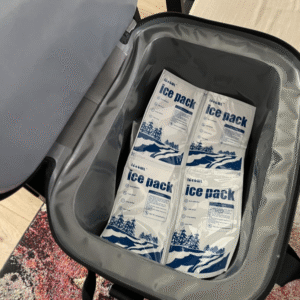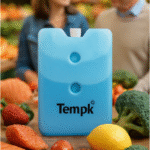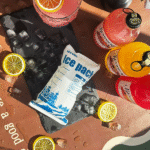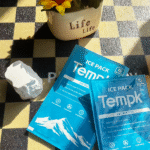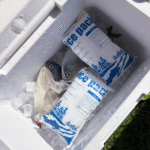Bester Trockeneisbeutel für eine Kühlbox: Was sollten Sie verwenden??
Wenn Sie Impfstoffe verpacken, gefrorene Mahlzeiten, oder ein Wochenendausflug, das Richtige wählen Trockeneisbeutel für eine Kühlbox bestimmt die Sicherheit, Haltezeit, und Produktqualität. Trockeneis hat eine Temperatur von −78,5 °C und wird zu CO₂-Gas, Ihre Tasche muss also isolieren, widerstehen Pannen, Und ermöglichen eine sichere Entlüftung. In diesem Leitfaden werden Taschentypen verglichen, zeigt Ihnen Schritt für Schritt, wie Sie packen, und verfügt über einen 2-Minuten-Selektor, um schnell die richtige Wahl zu treffen.
-
Welche Der Beuteltyp hält Trockeneis am längsten und dabei sicher bleiben (Isolierter Liner, HDPE/LDPE, EPS/VIP-Optionen)
-
So packen Sie einen Trockeneisbeutel für eine Kühlbox in fünf Schritten, um Druckaufbau zu vermeiden
-
Wie viel Trockeneis benötigen Sie? für 24–72 Stunden mit einfachen Faustregeln
-
Was nicht zu tun (Luftdichte Verschlüsse, Softkühler ohne Entlüftungswege, direkter Lebensmittelkontakt)
-
2025 Kühlkette Trends die die Nachhaltigkeit und Überwachung verbessern
Welcher Trockeneisbeutel für eine Kühlbox hält die Kälte am längsten??
Kurze Antwort: Eine isolierte, Entlüftungsfähige Auskleidung in einem starren Hartkühler liefert die beste Mischung aus Haltezeiten, Haltbarkeit, und Sicherheit. Verwenden Sie eine hochbelastbare HDPE/LDPE-Auskleidung nur als Innenhülle – nicht als primäre Isolierung – damit CO₂ entweichen kann, während der Kühler für Struktur sorgt.
Warum funktioniert es: Trockeneis sublimiert schneller, wenn es warmer Luft ausgesetzt wird. Eine geschlossenzellige isolierte Auskleidung verlangsamt die Wärmeentwicklung, während ein starrer Kühler vor Pannen schützt. Fügen Sie einen kontrollierten Entlüftungspfad hinzu (Rissiger Abfluss, Dichtungsspalt) damit CO₂ austreten kann. Diese Kombination ist zuverlässig für Lebensmittel und Pharma, und es ist einfach zu wiederholen, um konsistente Ergebnisse zu erzielen.
HDPE/LDPE-Liner vs. Isolierte Trockeneisbeutel – wie sollten Sie wählen??
Gehen Sie isoliert vor wenn Sie lange Haltezeiten oder häufiges Öffnen des Deckels benötigen; Verwenden Sie HDPE/LDPE-Auskleidungen für eine saubere Handhabung in einem harten Kühler, wenn die Fahrten kurz sind und das Budget wichtig ist. Wenn Sie mehrere Tage versenden, Fügen Sie über dem Trockeneis eine Schaumstoffplatte oder eine EPS-Deckelschicht hinzu, um die Sublimation zu verhindern und den Inhalt vor direktem Kontakt zu schützen.
| Kühloption (2025) | Isolierung | Entlüftungspfad | Was es für Sie bedeutet |
|---|---|---|---|
| Isolierter Trockeneis-Liner (geschlossenzellig) | Hoch | Verwenden Sie einen kühleren Abfluss bzw. einen gesprungenen Deckel | Beste Haltezeit; wiederverwendbar; sicherer für mehrtägige Reisen |
| Robuster HDPE/LDPE-Beutel (dicker Liner) | Niedrig-Mittel | Tun nicht luftdicht versiegeln | Sauberere Handhabung; Gut für Kurzstrecken in einem harten Kühler |
| EPS (Styropor) Einlege- oder Deckelbrett | Hoch (zerbrechlich) | Entlüftung über Außenkühler | Starke Isolierung, Budgetfreundlich; als Topping hinzufügen |
| Wiederverwendbare, weiche, isolierte Tragetasche (entlüftet) | Medium | Entlüftungsspalt muss vorhanden sein | Komfortabel; Verwenden Sie es für kurze bis mittlere Fahrten, wenn der Hersteller Trockeneis zulässt |
Praktische Tipps, die Sie heute bewerben können
-
Kühlen Sie den Kühler vor für 30–60 Minuten mit Opfer-Eisbeuteln.
-
Schichten Sie es auf: Trockeneis an der Unterseite → dünne Pappe/Schaumstoffplatte → Produkt → Isolierdeckel.
-
Füllen Sie tote Luft auf: Leerer Raum beschleunigt die Sublimation – fügen Sie Handtücher oder gefrorene Gelpackungen hinzu, um Hohlräume zu reduzieren.
Real -World -Fall: Ein regionaler Versender von Essenssets reduzierte den Verderb, indem er auf isolierte Einlagen und einen belüfteten Ablassstopfen umstieg. Auf den gleichen Wegen blieben die Mahlzeiten durchgefroren 48 Stunden mit weniger erneuten Eiseingriffen.
Wie verpacke ich einen Trockeneisbeutel für eine Kühlbox sicher??
Kernschritte (der Reihe nach folgen):
-
Tragen Sie isolierte Handschuhe und Augenschutz. Behandeln Sie Trockeneis wie ein Elektrowerkzeug.
-
Den Kühler vorab auskleiden mit einem isolierter Trockeneisbeutel oder hochbelastbare HDPE/LDPE-Auskleidung (Tun nicht Siegel).
-
Legen Sie Trockeneis auf den Boden. Verwenden Sie in Kraftpapier eingewickelte Blöcke/Pellets, um den direkten Kontakt zu begrenzen.
-
Fügen Sie eine Trennebene hinzu (Pappe oder Schaumstoffplatte), Dann Produkt laden. Zum Schluss einen Isolieraufsatz auftragen.
-
Erstellen Sie einen Entlüftungspfad. Öffnen Sie den Ablassstopfen oder die Deckelverriegelung leicht, damit CO₂ entweichen kann. Verwenden Sie niemals luftdichte Verschlüsse.
Wie wäre es mit einem Soft Cooler??
Wenn der Softkühler ist luftdicht, Kombinieren Sie es nicht mit Trockeneis. Es kann sich Druck aufbauen. Wenn der Softkühler ist Vom Hersteller für Trockeneis zugelassen und Sie können einen kontrollierten Entlüftungsspalt erzeugen, Für kurze Läufe ist es in Ordnung. Im Zweifelsfall, Verwenden Sie einen starren harten Kühler mit bekanntem Entlüftungsweg.
Wie viel Trockeneisbeutel für eine Kühlbox Benötigen Sie wirklich??
Faustregel für den Schnellstart (konservativ):
-
24 Std.: ~10–20 Pfund (4.5–9 kg) für einen Hartkühler von ca. 40 qt bei Raumtemperatur
-
48–72 Stunden: Linear skalieren, Fügen Sie dann 20–30 % hinzu, wenn Sie den Deckel häufig öffnen oder bei heißem Wetter laufen
-
Kurze lokale Läufe: Ein paar Pfund in einer isolierten Auskleidung können ausreichen, wenn die Ladung bereits gefroren ist
Diese Zahlen variieren je nach Kühlerkonstruktion, Umgebungstemperatur, Produktmasse, und Deckelöffnungsfrequenz. Beginnen Sie konservativ, dann nach einem Testlauf mit einem Sondenlogger optimieren.
2-Minutenwähler (Mini-Tool zum Kopieren und Einfügen)
Was soll man nicht Verwenden Sie als Kühlbox einen Trockeneisbeutel?
-
Nicht versiegeln Trockeneis in einem luftdichten Beutel, Krug, oder kühler. Gas braucht einen Ausweg.
-
Verwenden Sie keinen direkten Kontakt Fügen Sie zwischen Trockeneis und empfindlichen Lebensmitteln ein Trennblatt hinzu.
-
Nicht in Glas verpacken oder dünne, spröde Kunststoffe.
-
Verwenden Sie keine nicht zugelassenen Softkühler mit luftdichten Reißverschlüssen.
-
Nicht in unbelüfteten Räumen transportieren. Fenster knacken; Vermeiden Sie enge Stämme.
2025 Entwicklungen und Trends für Ihren Trockeneisbeutel für eine Kühlbox
Was ist neu in diesem Jahr: Die Zahl der wiederverwendbaren Isolierversandgeräte wächst schnell, da Marken sich mit Abfall und Kosten auseinandersetzen. ISO 23412 prägt weiterhin Last-Mile-Prozesse für temperaturgeführte Pakete. Weitere Betreiber hinzufügen Smart Sensoren zur Temperatur-/CO₂-Überwachung. Erwarten Sie eine breitere Akzeptanz von recycelbare Liner und EPS-Light-Designs, die dennoch mehrtägige Leistung bieten.
Was sich ändert auf einen Blick
-
Mehrwegsysteme nehmen zu: Niedrigere Gesamtkosten gegenüber wiederholten Fahrspuren; weniger Einwegartikel.
-
Sensorgesteuerte Fahrten: Kostengünstige Logger und CO₂-Monitore reduzieren Überraschungen beim Transport.
-
Design für Recycling: Einlagen aus Monomaterial und einfachere Trennungen erhöhen die Rückgewinnungsraten.
Market insight: Analysten gehen davon aus, dass der Markt für Kühlkettenverpackungen im Laufe des Jahrzehnts wachsen wird, mit Mehrweglösungen und intelligente Verpackungen Führendes Wachstum bei steigenden E-Lebensmittel- und Biologika-Volumen.
FAQ
Kann ich einen Plastikbeutel mit Reißverschluss als primären Trockeneisbeutel für eine Kühlbox verwenden??
NEIN. Zip-Seal-Beutel können Gas einschließen und platzen. Verwenden Sie einen unversiegelten HDPE/LDPE-Liner innen einen starren Kühler und sorgen Sie für einen Entlüftungsweg.
Kann ich Trockeneis in einen Softkühler geben??
Nur wenn der Hersteller Trockeneis ausdrücklich zulässt Und Du kannst es entlüften. Luftdichte Softkühler können gefährlichen Druck aufbauen.
Wo soll das Trockeneis im Kühler bleiben??
Ganz unten, dann ein dünnes Trennblatt, dann Ihr Produkt. Fügen Sie einen Isolieraufsatz hinzu, um die warme Luft zu verlangsamen.
Wie entsuche ich das übrig gebliebene Trockeneis sicher?
Lassen Sie es in einem gut belüfteten Außenbereich, fern von Kindern und Haustieren, sublimieren. Gehen Sie niemals in ein Waschbecken oder eine Toilette.
Welche Handschuhe soll ich verwenden??
Isolierte oder kryogentaugliche Handschuhe. Vermeiden Sie Baumwolle allein; es kann gefrieren und an der Haut kleben.
Zusammenfassung & Nächste Schritte
Key Takeaways: Verwenden Sie eine isoliert, Entlüftungsfähige Auskleidung in einem harten Kühler als Ihre primäre Trockeneisbeutel für eine Kühlbox. Behalten Sie ein Entlüftungsweg, hinzufügen Trennblätter, Und Füllen Sie tote Luft um die Sublimation zu verlangsamen. Beginnen Sie mit konservativen Trockeneismengen, Protokollieren Sie einen Versuch, dann stimmen.
Mach das als nächstes:
-
Wählen Sie einen isolierten Liner + Starre Kühlerkombination.
-
Packen Sie mit der 5-Schritte-Methode und öffnen Sie den Abfluss zum Entlüften.
-
Testen Sie einmal mit einem Sondenlogger, Wenden Sie dann den oben genannten Schätzer an, um die richtige Größe Ihres Trockeneises für zukünftige Läufe zu ermitteln.
Über Tempk
Wir entwickeln praktische Inhalte und Tools zur Kühlkette für Teams, die temperaturempfindliche Waren versenden. Unsere Empfehlungen konzentrieren sich auf Wiederholbarkeit Und Sicherheit– Von isolierten Linern bis hin zu Packouts können Sie in wenigen Minuten trainieren. Wir legen Wert auf Wiederverwendbarkeit, Entlüftungssichere Lösungen, die Kosten und Produktschutz in Einklang bringen.
Brauche Hilfe? Buchen Sie mit unserem Team einen 15-minütigen Pack-Out-Test.






